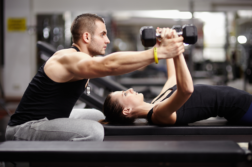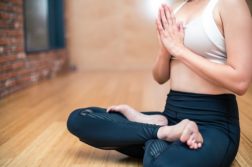The holy grail of fitness achievement: the Six-Pack. Sure, we all want that fit, toned abdomen and the self-confidence and health benefits that go with it. But how do you achieve those results? While there are countless exercises that promise to deliver results for your abs, few are as effective as reverse crunches. Reverse crunches require no special equipment, are easy to learn, and can give you the whole abs workout you are looking for. If you make sure that you perform the movement properly, you will get results without risking injury.
What Are Reverse Crunches?

Image via Pexels
A Variation on a Classic
Reverse crunches are a variation of the traditional crunch exercise. Crunches are usually performed lying on your back with your feet planted on the floor. In the traditional crunch, your lower half stays perfectly still while you engage your core to lift your head and shoulder blades off the ground. Reverse crunches bring the lower half of your body into the movement. With your feet off the ground, this slight variation of the crunch engages even more of your core muscles.
Upper Abdominal Workout
Both the standard crunch and the reverse crunch are meant to engage the upper abdominal core muscles. The motion of the head and shoulders coming off the ground is not an effort of the arms or neck, but rather the upper abdominal muscles are engaged to draw the upper body off the floor.
Lower Abdominal Workout
It is only the reverse crunch that also engages the lower abdominal muscles. With the feet off the ground and the hips being lifted off the floor, the lower abdominal muscles engage as to draw the lower half up.
No Accessories Needed
The reverse crunch is a great example of an exercise that is challenging and effective requiring no fancy equipment or help from another person. All you really need is a flat surface, and the space required to lie down and do a standard crunch. We recommend that you find a surface that is somewhat soft to prevent discomfort or injury to your lower back, but a simple yoga mat or soft carpeted floor would do just fine.
Challenge Yourself
Even within the reverse crunch there are slight variations you can use depending on your fitness level. Small variations like putting your feet down after every rep, not lifting quite so high off the floor or even limiting the number of reps can make this move easier to achieve initially and help build your confidence. On the other hand, you can keep your feet off the floor and even extend them out parallel to the floor at each rep to increase the intensity. You can even use an inclined bench to start with feet below your shoulders to make your reverse crunches an extreme abs workout.
Who Should Do Reverse Crunches?
Reverse crunches are a great challenge to athletes of varying levels, strength, and ability. However, reverse crunches should be part of a larger arsenal of core strengthening exercises. If you have built up a fair amount of baseline core strength, the reverse crunch is a great addition to really shred those abs with even a few reps.
Also, if you already struggle with significant lower back pain, be careful as reverse crunches may not be right for you. If you spend lots of time on your feet each day, reverse crunches could be the perfect way to strengthen those lower abs that can be a troublesome area. They also place less stress on your lower back than traditional crunch exercises.
How To Do Proper Reverse Crunches
Take This Lying Down
Find a flat, safe surface and lie with your knees bent and feet flat on the floor. You can also perform reverse crunches on a padded bench or you can use a padded mat for additional protection of your back. Interlace your fingers and place them behind your head to provide support as you lift off the floor. Make sure you have a few feet of space around you to perform the movement. Now you are ready to go.
Protect Your Head
One of the most common incorrect ways to do a reverse crunch is to strain with your neck and pull your head up with your hands and arms. Remember that your hands are only in place behind your head to provide support as your head and shoulders lift off the mat. Straining and pulling with your hands not only risks injury to your neck, but it also does not properly engage your abdominal muscles and you will get less benefit from the exercise. It would be a shame to aim for those perfect abs only to end up with a pain in the neck!
Step By Step Instructions
- 1Start in your traditional crunch position with your feet flat on the floor and hands behind your head
- 2Lift your feet off the ground while keeping your knees bent and legs at a 90-degree angle
- 3Using your core, pull your knees toward your chest so that your tailbone raises off the ground
- 4At the same time, do a crunch, lifting your shoulder blades off the ground–do NOT use your hands and arms
- 5Slowly lower your shoulders and hips, returning to your starting position
- 6Focusing on squeezing your abs, repeat the movement without using your momentum from the previous rep
- 7Perform 3 sets of 10 repetitions until you get comfortable with the motion
- 8Increase the sets and reps for a greater challenge and ultimate results
A Simple Training Aid
While reverse crunches do not require any equipment, you can use a foam roller to help keep your legs in the right position. Placing the foam roller behind your knee and then squeezing it between your calves and thighs as you engage your core and lift your hips, you will maintain the proper position of your legs and ensure that your core muscles are fully engaged the whole time.
No products found.
Alternative Starting Position
If you find you cannot do reverse crunches without using your hands and pulling on your head, you can also perform the exercise with your arms extended at your side and your palms flat on the floor to begin. In this position, your arms and hands remain at your side as you squeeze your abs and lift your hips and shoulders at the same time. This position does not provide the same support for your head and neck, but it is good to help prevent injury.
Reverse Crunch, Without The Crunch?
You can also perform a variation of this exercise without lifting your head and shoulder blades at all. While this variation of the reverse crunch will not engage the upper abdominal muscles, it can still really torch those lower abs. Use the starting position of placing your arms at your side, then lift your feet, engage your core, and lift your hips off the floor. Returning slowly to the starting position, extend your feet parallel to and a few inches off of the floor. Repeat without placing your feet on the floor or using your momentum and you’ll have those lower abs burning in no time!
Inclined to Take on More?
By simply using gravity you can increase the intensity of the reverse crunch and really drive for those six-pack results. Using an inclined bench, start with your head toward the top of the inclined bench, bracing yourself with your hands. With your feet below your shoulders, lift your feet and legs off the bench and engage your abs until your hips are lifted off the bench and then lower them slowly. For a real challenge, keep those legs perfectly straight!
Common Mistakes
The reverse crunch is an undeniably effective way to build core muscles. However, there are some common mistakes in form that can reduce the effectiveness of the move. By trying to execute the reverse crunch too fast, you risk using your momentum to get your hips off the floor as opposed to fully engaging your core. Be sure to do fewer reps in order to slowly to get the maximum benefit from reverse crunches. It is important that you try to push your knees and hips toward the ceiling. Simply rolling your knees to your chest without lifting your tailbone will sap most effectiveness right out the reverse crunch.
Conclusion
Fit, cut, six-pack abs are one of the most rewarding physical benefits of exercise and staying in shape. But it can be a real challenge to engage every muscle in the group in one challenging movement. The reverse crunch, when performed correctly, can really torch your core and deliver the results you are looking for. Whether you are just starting on your fitness journey or are an experienced gym rat, the reverse crunch comes with challenges in form and reps for every ability level. So enough reading! Get out there and reverse crunch your way to your perfect set of six-pack abs.
Last update on 2024-06-20 at 22:05 / Affiliate links / Images from Amazon Product Advertising API



